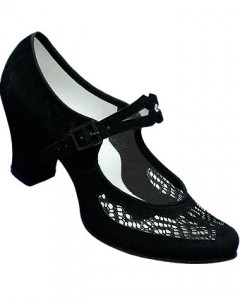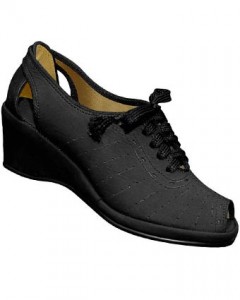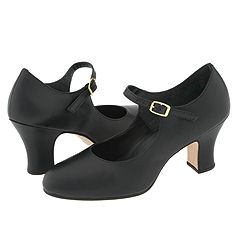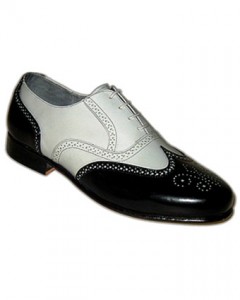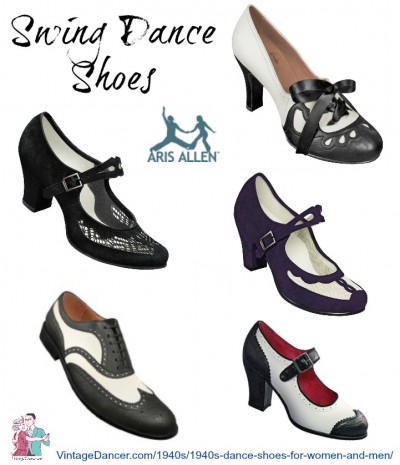
1940s Swing Dance Shoes by Aris Allen- Click to buy Dance Shoes
Are you a swing dancing, Lindy hopping, jitterbugging, shag or Balboa dancer? If so, you belong with me in the heart of the swing era- the 1940s. Regardless of your favorite 1940s dance style, you will eventually need a pair of vintage style dance shoes to go with your 1940s dance dress or 1940s menswear.
Back in the 1940s, there wasn’t a need for special dance shoes. Everyday women’s shoes and men’s shoes of the ’40s had smooth leather soles, which made them ideal for dancing and street wear. Some people did save certain shoes for evenings and these were probably worn for swing dances as well. However, since swing dancing was mostly a young person’s activity and young kids were more causal than their elders, it wasn’t uncommon to see kids dancing in sandals or casual loafers.
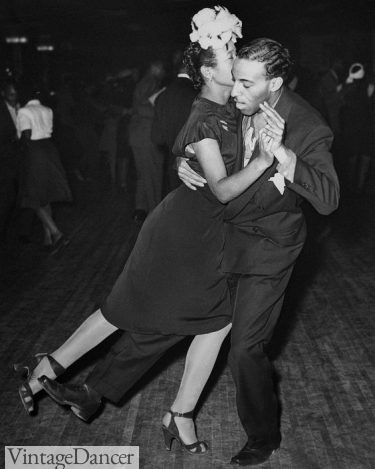
Swing dancing
Today our day-to-day shoes are usually rubber soled, which is not good to dance in. Special dance shoes are necessary. Dance shoes usually have smooth leather soles, padded, breathable inner linings, and a breathable leather or fabric body. Many also have hard toes- a plastic cap inside- to help prevent the discomfort of being stepped on – ouch!
Since we want to be fashionable to the ’40s we need authentic looking vintage dance shoes. (Swing dance shoes also could be ’30s and ’50s styles, but I’ll just focus on the ’40s for now). There are a few makers of vintage dance shoes, who make authentic vintage dance shoes with the comfort and smooth sole necessary for energetic dancing. See the list at the end of the page.
1940s Women’s Dance Shoes
Everyday shoes of the 1940s consisted of several new styles: the slingback, peep toe, wedge, and combinations of these styles. You can read more about 1940s women shoe styles here.
One really big difference between the 1940s and any other era is the materials shoes were made of. With WWII in full swing, most leather was manufactured into equipment and boots for the soldiers. That meant ladies had to use other materials. Velvet, mesh, and reptile skins were the most available and sturdy shoe materials.
Besides material, the ’40s made strides with cuts and styles as well. These shoes feature a wedge heel which gave women a bit more height but were far more stable to walk (or dance) in. They also have a slingback heel strap, which was very popular in summer. No decade before the ’40s dared to expose as much foot skin as these sandals.
What makes these great for dancing is the sturdiness of the wedge heel. I don’t like wearing heels in general, but I’m short and I have a tall dance partner so the extra height is very useful.
These wedge shoes have the other very popular element of 1940’s women’s shoes: the peep toe. This sexy little opening on the front of the toe was the first time an open toed shoe was worn in history. People thought open toed shoes were dangerous to wear, so this little peep toe was all that was allowed. It is the best symbol of 40’s shoe fashion and one that I simple adore. Peep toe shoes are experiencing a fashion revival today, making them a lot easier to find.
Basic character shoes, like these from Capezio, are a standard shoe design that has remained popular for nearly a half a century. From the Victorian era through the 1950s, these moderate heeled, black, Mary Jane strap shoes look authentic for the all decades. If you are on a budget, just getting started in dance, or plan to learn many different eras of vintage dance, then these shoes are a must have.
1940s Men’s Dance Shoes
Unfortunately, men, you don’t have the variety of shoe choices that women have. Not because manufactures aren’t making 1940s dance shoes for men, but because there simply weren’t many styles of shoes for men in the 1940s. All eligible men were off at war, so the remaining men just wore the same shoes they had in the 1930s.
From the 1920s on through the early 1950s, men’s shoe styles didn’t change much. The basic lace-up dress shoe, known as an Oxford, in brown or black was the most common shoe. In the 1930s, broguing (small holes) were added to the shoes and the wingtip (see pointed W tip on shoe above) style changed up the standard Oxford. Two-tone black and white or brown and white shoes were another snazzy alternative for semi formal and formal wear. Today, swing dancers love wearing two toned Oxfords and wingtips. Their uniqueness really adds that extra vintage flash to swing dancing that dancers and audiences love to see.
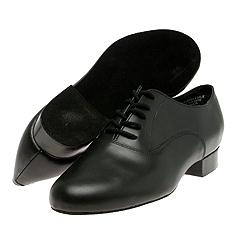
Ballroom shoes
If snazzy and jazzy aren’t your thing, or you just need a good shoe to start out with, then the basic men’s ballroom dance shoe is all you need. Its plain Oxford design goes well with most dance eras. Attend any dance event and you will see more men wearing this shoe than any other. It’s comfortable, has a smooth sole, and some varieties have hard toes. These are often called Latin ballroom dance shoes.
Shop for men’s vintage dance shoes here.
Practice Shoes for Men and Women
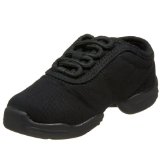
Dance Sneakers
Although dance sneakers are not anywhere close to shoe styles of the 1940s, they are wonderful to dance in. I use my pair for almost every dance I attend unless it’s a formal themed event. They are comfortable and have a lot of cushion, arch support, and a hard toe – which keeps accidental mis-stepped feet from landing on and injuring my toes.
I have heard from a few people who say the plastic bottoms on dance sneakers make spinning and sliding more difficult. I haven’t noticed this with my dance sneakers too much, so you will have to be the judge. For practice, I find that I slide and spin enough and then for formal dances I slip on my smooth soled shoes and really take off.
One last bit of advice for men. Most brands of dance sneakers are unisex but really made for women. They have extra large sizes for men. It can be a challenge to find comfortable dance sneakers if your feet are wide. Whenever possible, shop locally so you can try on shoes first or shop online with a store that has a free return/exchange policy (which most do now).
Dance Shoes Tips:
- Many dress shoes for men and women have smooth leather soles. These usually cost over $100 but can make excellent dance choices. They may, however, lack the breathable lining and hard toe.
- You can cheaply make any no slip shoe or sneaker into a dance shoe by sticking moleskin (found in the first aid section of your local drug store) onto the soles. It’s smooth, slippery, and cheap. For a more durable approach, try these stick-on leather soles. For something even nicer, take your shoes to a cobbler (shoe repair shop) and have your shoes resoled in leather. Shop 1940s style women’s shoes here and more 1940s style men’s shoes here.
- I try to avoid performance ballroom dance shoes because they are often made of synthetic materials (no breathing) and have no cushion support insoles. Other dancers I know love them.
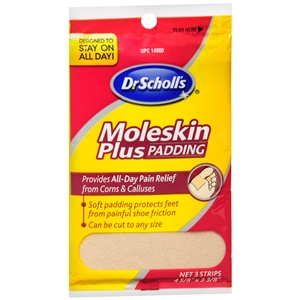
Mole Skin- Instant smooth soles
Buy Vintage Style Dance Shoes
Shop women’s vintage style dance shoes
Dance Shoes Brands
Aris Allen – Swing dance shoes and clothing for ladies and gents. Shoes run narrow.
Apple Jacks – A new brand for Lindy and bal-swing dancers. 1910s-1930s styles currently.
Bloch– Standard dance shoes- ballet, tap, jazz, character, etc. Many vintage styles in black or tan.
Bleyer (UK)- Swing dance shoes for women and men
Saint Savoy (AT) – Shoes for dancers. 1920s and 1930s heels and Oxfords in unique color combinations.
Tranky shoes (IT) – A new brand of 30s and 40s men’s and women’s dance shoes. Online store coming soon. You can contact them via email or Facebook.
Harr Shoes (DE/UK)- Historical custom shoemaker for dance shoes, plus other brands.
SwingGear (UK) – Women’s dance shoes.
Slide & Swing (ES) – All leather men’s and women’s dancing shoes inspired by the 1930s and beyond. Low heels, Oxfords, sandals, and loafers.
Swivells (FR) Etsy Shop – Colorful shoes and boots to dance in. Designed by swing dancers and offered in a variety of happy colors. Very well made.
Madame Dynamite (Spain) Low and medium heel shoes for swing dancers
Harlem Shoes (Turkey) – Low heel dance shoes handmade in Istanbul
Elizabeth Shoes (Greece) – A handful of leather sole dance shoes for women and men.
HepCats Dance Shoes (Poland) – Vintage style T-bar and oxford shoes for swing dancers. Made in Poland.
Bouncies (France) are charming little shoes designed for the comfort and inspiration of lindy hoppers. Low heels. Simple designs
Bop Jonny’s (AU)- Largest selection of retro and swing dance shoes in Australia.
Debbie Sessions has been teaching fashion history and helping people dress for vintage themed events since 2009. She has turned a hobby into VintageDancer.com with hundreds of well researched articles and hand picked links to vintage inspired clothing online. She aims to make dressing accurately (or not) an affordable option for all. Oh, and she dances too.
